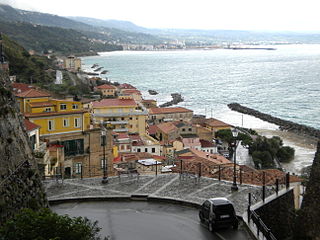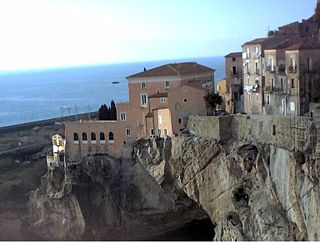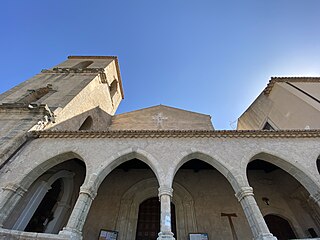
The House of Fieschi were an old Italian noble family from Genoa, Italy, from whom descend the Fieschi Ravaschieri Princes of Belmonte. Of ancient origin, they took their name from the progenitor Ugo Fliscus, descendants of the counts of Lavagna.

Pizzo, also called Pizzo Calabro, is a seaport and comune in the province of Vibo Valentia, situated on a steep cliff overlooking the Gulf of Saint Euphemia.

Gerace is a town and comune in the Metropolitan City of Reggio Calabria, Calabria, southern Italy. Gerace is located some 10 kilometres (6 mi) inland from Locri, yet the latter town and the sea can be seen from Gerace's perch atop a 500-metre (1,600 ft) vertical rock. The town stands on a hill formed of conglomerates of sea fossils from 60 million years ago. It is one of I Borghi più belli d'Italia.

Badolato is a comune and town in the province of Catanzaro in the Calabria region of Italy. As of 2013 Badolato had an estimated population of 3,152. It is one of I Borghi più belli d'Italia. It was chosen as the second most beautiful village in Italy in April 2024 in a national RAI TV series.

Amantea is a town, former bishopric, comune (municipality) and Latin Catholic titular see in the province of Cosenza in the Calabria region of southern Italy.

San Pietro in Amantea is a village and comune in the province of Cosenza in the Calabria region of southern Italy.

Prince of Belmonte is a noble title created in 1619 by the Spanish crown for the Barons of Badolato and Belmonte. The name of the title is taken from the fortress town of Belmonte in Calabria, historically important for the defence of the Italian coast from Saracen invasion. Belmonte has been known since the Risorgimento as Belmonte Calabro.

Marquess or Marchioness of Galatone was a noble title created by the Kings of Spain for Stefano Squarciafico, Patrician of Genoa, on 29 June 1562, and inherited according to Spanish nobiliary law. The title is currently held by the Prince or Princess Belmonte.

Chiaia is an affluent neighbourhood on the seafront in Naples, Italy, bounded by Piazza Vittoria on the east and Mergellina on the west. Chiaia is one of the wealthiest districts in Naples, and many luxury brands have shops on its main street. It is also home to a business school and a medical school, as well as other public schools.
Orazio Giovan Battista Ravaschieri Fieschi was a wealthy nobleman and patrician ('patrizio') of Genoa descending from the Fieschi, Counts Palatine of Lavagna, in what is now Liguria. He was appointed Grand Seneschal of Naples, and, on 5 March 1619, he was elevated to the title of Prince of Belmonte at Madrid by Philip III of Spain. Orazio descended from a line of imperial and royal bankers, his great-grandfather Giovan Battista and grandfather having been Treasurers to Charles V, Holy Roman Emperor, and King Philip II of Spain respectively.

Campora San Giovanni is a frazione of the comune (municipality) of Amantea, in the province of Cosenza, Calabria, Italy, located close to the border with the province of Catanzaro.
Palazzo Ravaschieri Fieschi della Torre or Palazzo Ravaschieri Fieschi-del Giudice is a 16th-century noble palace in the historical center of Belmonte Calabro in the province of Cosenza, Calabria, southern Italy.
Palazzo Rivellino, also called Rivellino, is a historical building in the municipality of Belmonte Calabro, in the province of Cosenza, Calabria, southern Italy.

The Castello di Milazzo is a castle and citadel in Milazzo, Sicily. It is located on the summit of a hill overlooking the town, on a site first fortified in the Neolithic era. The Greeks modified it into an acropolis, and it was later enlarged into a castrum by the Romans and Byzantines. The Normans built a castle, which was further modified and enlarged during the Medieval and Early Modern periods. It is now in good condition, and open to the public.

The Palazzo Ravaschieri di Satriano is a monumental palace on the Riviera di Chiaia number 287, in Naples, Italy.

The House of Pignatelli is the name an old and prominent Neapolitan family of Italian nobility, clergy, men of arts and sciences, whose members occupied significant positions in 18th and 19th century. The family has been regionally prominent since the 13th century. Among various titles, they held the title of Prince of the Holy Roman Empire.

The strada statale 18 "Tirrena Inferiore" is an Italian state road, connecting Campania and Calabria. It is among the longest and most important state highways in southern Italy, considering that it follows the Tyrrhenian coast, from Salerno to Reggio di Calabria.

The Amantea Castle is located in the town of the same name, in the province of Cosenza, in the lower Tyrrhenian Sea of Cosenza. Dominating the coastal road and the road to Cosenza that runs along the Catocastro River valley, it was once an important stronghold under the Byzantines, Arabs, Normans, Swabians, Angevins and Aragonese. It was restored in the viceregal period and under the Bourbons, but suffered severe damage during the earthquakes of 1638 and 1783; it was left in a state of neglect after the disastrous 1806-1807 siege suffered by Napoleonic troops.

The Church of San Bernardino da Siena is a Catholic place of worship in the Italian municipality of Amantea, in the province of Cosenza in Calabria. It is situated 34 metres (112 ft) above sea level on the street of the same name in the Tyrrhenian town.



















